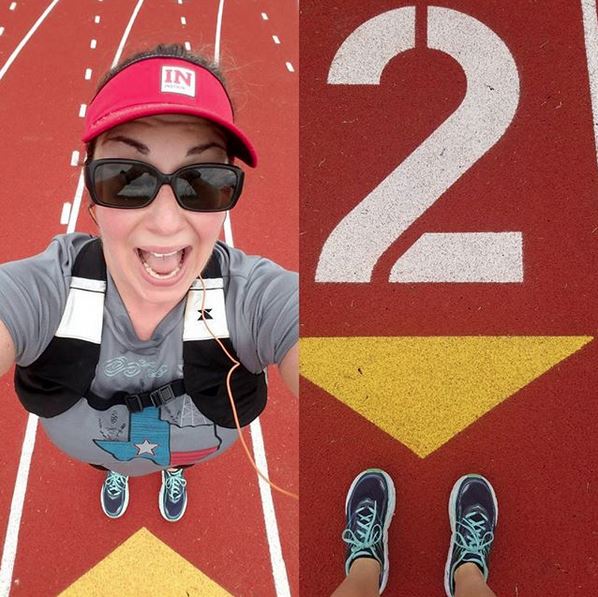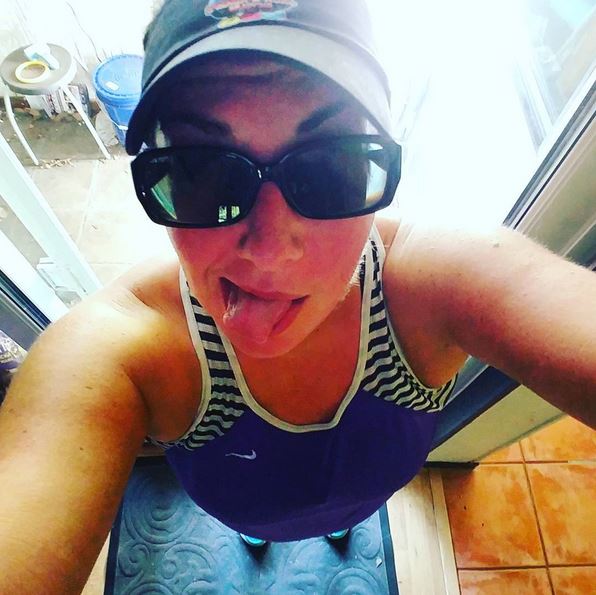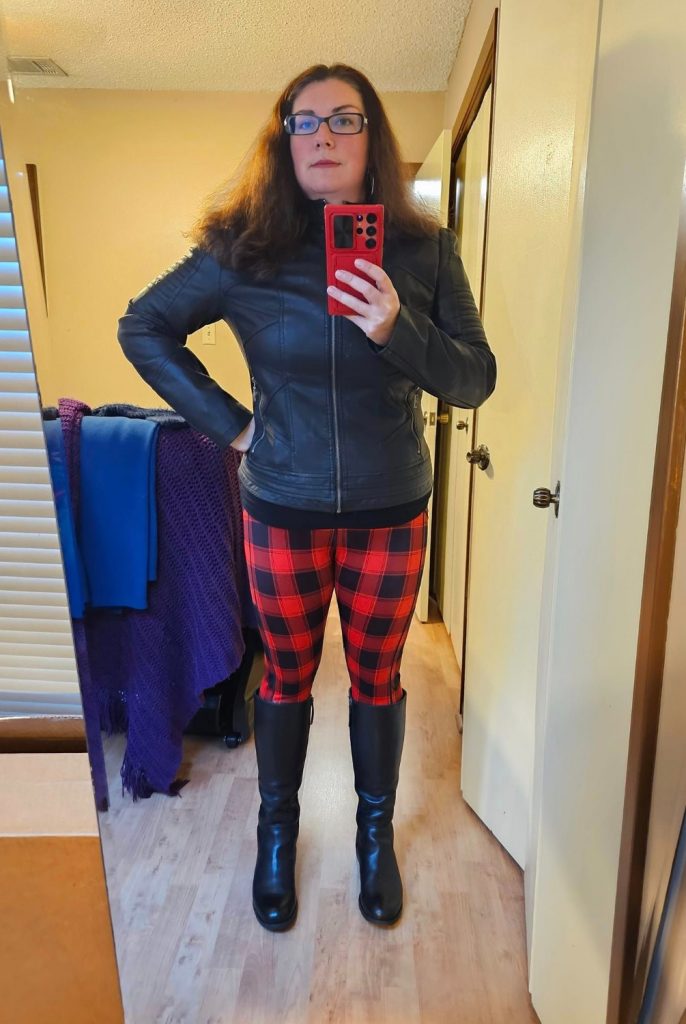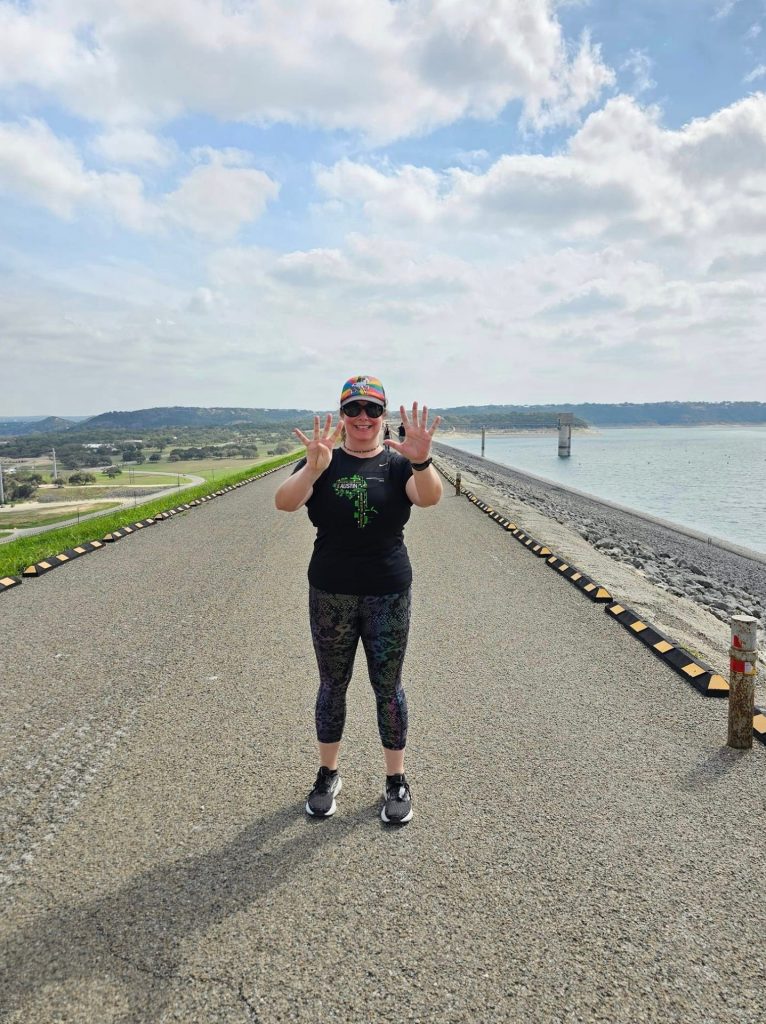So, I got a good deal on THIS BOOK and devoured it on vacation.

Actual proof on my flight to Bonaire. Yeah, this is my idea of fun people. Shut up.
Then, I had to re-read it and take notes at home because the absolute worst place to read a book about form and drills is on a long plane flight where you can’t move at all.
I’ve been talking about improving my running form for years now, and I’ve done very little about it. After being schooled on what to do by Jonathan Beverly, and spending a few weeks trying it, I’ve come to some conclusions:
First, being conscious about a small handful of things while I run really helps my stride. I was overwhelmed previously – I didn’t know what was wrong, and I didn’t know what to do to fix it. Now, I have a handful of cues I can think of while running that instantly perk me up and make me more efficient.
Second, dynamic warmups/drills are not just wastes of time. Honestly, I’ve been iffy on the first mile drills – they’re inconvenient when I’m running on the treadmill and they can irritate my cranky ankle/foot, but the dynamic warmup is AWESOME and has helped me pinpoint some spots where I need more flexibility and strength.
Finally, there are tons of things you can do in your spare time without much interruption to your daily schedule to improve your strength, flexibility, and posture. You just have to make them habits. That’s the hard part and from the last few weeks, I’ve found that doing them in stages is helping.
So, consider this both a book review and also an action plan, but definitely not a “how to fix your running stride” guide because I’m three weeks in and I’m still VERY new at this. Let me summarize what steps I’m taking going forward to help my running stride transform from a tight-hipped Frankenstein to a lithe gazelle this year!

Hopefully spending more time HERE will help.
Pre-running program:
- Find my balance posture (get my hips stacked properly – weight off heels and on your midfoot, can see tops of shoelaces). If you’re not normally in the right alignment, this feels a little weird and takes some adjustment to get into but feels awesome when you do.
- Contract my transvers abdominal muscle (TVA) to activate 5-10 times
- Lunge matrix (front, front w/twist, side, 5/7 o’clock, backwards). Here’s a video showing what to do. I’m actually glad I found this because there were two I wasn’t doing correctly (twist, 5/7 o’clock) and one I forgot (back).
- Leg swings 10x each leg (just as it sounds, stand in a doorway holding the frame and swing your legs from front to back). This makes it pretty apparent if you have tight hips or not (I do).
Things I would like to include in the future:
- 10xeach side single leg squat with quad stretch
- Forward lunge with leg drive
- Wall push offs x5 each side
However, I want to get to the point where the first four things are completely ingrained in me before I pile on more.
As run starts I do some drills within the first mile to loosen my stride up – at least, when I have been doing it. Once I resolve the cranky ankle issue (orthodics, apparently…. whomp whomp), I plan to be strict on this:
- High knee running (make sure you’re stretching your hip flexor not contracting it)
- Skips – just like when you were kids (focus on tall posture and downward drive of leg)
- Butt kicks
- Caricoa
- Backwards running
Now, you’ve warmed up with a dynamic warmup and you’ve done drills. You’re done, right? Nope. Fixing your stride will take a conscious effort for months until it feels natural, so I’ve been working on keeping these few cues in my head and trading off focuses every mile so it doesn’t get overwhelming.
- Push your arms back (if you can see your hands during the full running stroke, they’re too far forward). Every stride they should graze your waistband or at least dissapear from your field of view.
- Run tall. Head up over shoulders, look to horizon, chin back, chest up, shoulders back, hips aligned. This sounds SO EASY but it’s the thing I have to remind myself of most often as I like to look down just in front of my feet, and that tanks the rest of my posture.
- If you feel fatigued, change up your cadence. Sometimes that’s all you need to shake yourself out of it. I find doing a mile of higher cadence early in the workout usually naturally improves my cadence the rest of the run without thinking about it.
- Run quiet/soft (this usually helps me increase my cadence).
- When you feel slouchy/saggy – do the hallelujah drill (arms up, opening chest, then circle back down). It puts you in a better posture. You don’t have to SAY Hallelujah! though (but you do you).
- One thing that helps me a lot is concentrate on driving my stride with my hips (which helps me work on hip extension). This wasn’t in this particular book but something I was working on last year.
- Run some strides every run (quick as possible while staying relaxed, shut down as soon as you get to top speed, about 10 sec). I have been… iffy on this. I was doing them at the end of each run if the run itself didn’t have speedwork and then I kind of tapered off…

Whew, that’s a lot!
That’s not the only piece of the puzzle, though. We spend a handful of hours per week running, and then those of us with desk jobs spend the rest of the week ruining that work hunched over, sitting, and can even wreck it depending on how we sleep. How do you counteract that? More stretching and strength work.
Stretching/rolling program (the goal is to get through these all 3x week):
- 3-5 min hip stretch each side (foot up on chair or counter)
- Shoulder mobility test (5x each side)
- 2 minutes tennis ball on shoulders (lying on your back)
- 3-5 min foam roller chest stretch
- 5-10 min forearm roller lat stretch
- 3 min doorway lat stretch
- Foam roller lat release (shoulder to mid-chest each side)
- Shoulder passthroughs with stick x15-30
- Towel pull/sideways pull with foot – essentially put a book on a towel and use only your toes to bring the book to you (two towel lengths)
I won’t lie – this is a lot all at once and the 3-10 minute price tag on some things means I haven’t been following this yet. However, I am working on establishing at least A stretching and rolling routine DAILY and once that’s a habit, I’ll work on upping the times and doing more of these specifically. I’ll also talk about these more once I’m doing them.
Then, there are some things you can do on the daily without really impacting your life that can help.
Every day at work sitting at my desk (starting this week):
- TVA contractions (like in the warmup) x10
- Foot splays x30 (spread your toes out as much as you can)
- Foot yoga (big toe up, other 4 up) x30
- Short foot (contract arch without using toes) hold for 6 sec, 5-10 times
Here are some things I would like to work up to:
- Ankle resistance (basically pushing against your ankle – up/down, forward/back left/right) hold for 10 sec, repeat 5 times
- Arm swings (open the chest, hold 2 sec) x10
- Single leg balance with eyes closed (30 sec each side)
Stuff to help posture on the daily:
- Balance on one foot while brushing teeth/putting on shoes and socks
- Pull shoulders back and raise your head high whenever you see a certain color or walk through a doorway
- Anytime you’re standing and waiting for something, rotate hips and focus your weight on your feet (not heels) – just like in the warmup.
- Squat when you’d usually bend

The last IG proof of stretching and rolling is back in March 2017. While that’s not completely factual, I definitely did fall off after IM peak training.
The last key is strength. Most of us, if we have imbalances, are quad dominant, and have glutes that don’t fire properly because they’re weaker and our bodies are incredibly good about benching inefficient muscles and subbing in ones that are stronger – even if it’s at the cost of form and efficiency. While the key with your hips is generally flexibility, with the glutes, you have to first make sure they’re actually firing at all. I find that the cue “drive with your hips” sets my glutes active, but you might need something else but once you get it, you can feel your glutest contract and if you haven’t been doing it properly in the past, your glutes will tell you after the run :).
So, the other key is to make buns of steel. Here are some exercises to make you sure get buns, hun.
- Bridge/marching bridge
- Air squats (with good form – with the chair of death to check it, hold pvc pip on your back and make sure it stays on), once this is comfortable jump squats, single leg squats
- Donkey kicks (advanced – from plank position)
- Clamshells
- Side leg lift (against a wall to ensure form)
In my Oiselle Dozen, I’m getting the essence of THREE of these. However, I know I need to start squatting next month with heavy things, so adding some air squats to work on form first won’t be the worst idea in the world.
Once you’ve got the technique, he suggests that you strength train to develop POWER. Some examples are:
- Ladder drills
- Micro hops
- Quick feet drills
I am not there yet but this will hopefully be a spring thing for me.
We disagree on core – he says that planks done properly are all you need. I think you need to work different muscles and change up the exercises so they don’t get stale. But, if you’re doing nothing and only have time for a few minutes to work your abs per week, that’s probably the best and safest thing you could do.
I’m going to include some other notes below from the book. I don’t have much other comment on them besides they were things that stood out as something I wanted to consider for 2018 (when planning training/purchasing new shoes).

Right now, the Hokas feel like the least amount of shoe I need for longer distances but we’ll see about that later this year…
Changing it up:
- Vary run types/surfaces as much as possible. Don’t do the same loop at the same pace over and over. Jump over obstacles. Chase faster people. Play running sometimes. Wear different shoes, not the same ones every day.
- Consider some barefoot work. Start with easy strides on grass (or the treadmill).
Some notes on shoes:
- Run in the least shoe possible
- What feels right is right
- Fit matters more than features
- Vary your shoes
- Make sure to replace and wear comfortable daily shoes (also consider getting a lower heel/toe drop casual shoe to see if they work better for running)
He recommends a sequence for days you’re time crunched (do this 5-8 times per leg), but honestly, the lunge matrix is working for me right now, so I’ll just leave this here as a possibility for later:
- stand tall
- lunge with hands over head (hip flexor)
- bring hands down, arm crosses over leg, drive right hip forward
- track start position, stretch heel, calf, hamstring
- stand up, drive back leg up to high knee position
- pull to chest, stretch glute
- kick leg back out, touch ground with opposite hand
- stand up straight and repeat on other leg
I’m doubtful I’ll see much improvement during 3M from any of this, but hopefully by the spring, I’ll be a little stronger, a little more flexible, a little lighter on my feet, and a little faster.




Comments are closed.